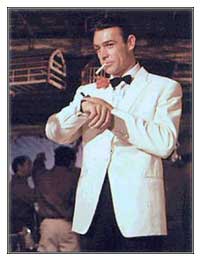For years, people in and out of Hollywood have argued whether films create cultural trends or simply mirror them. All such arguments tend to be rather simple-headed. Like the nature or nurture arguments of behavioral scientists, or the mind versus heart arguments of theologians, simple answers can only be drawn on paper. The realities are far too complex. Do films with heavy gun violence make kids who watch them more violent? Well, some, I suppose. But then again, they only do so because kids crave the violence, and the kids crave the violence most often because of some larger problems in our society. Do films that depict heroes who smoke make more people want to smoke? Well, it depends. They don’t make me want to smoke, but marketers assure us that positive images of smokers in film and television do lead some to go buy cigarettes.
Underneath, it’s all about identification. What makes a person watch a film like The Matrix and go buy a trench coat, or watch old Bogie films and try out cigarettes, or watch the latest Bond film and want a haircut like Halle Berry’s is the need for a defined position in the culture, an identifiable style that provides a context larger than the individual.

It used to be that individuals had more vertical relationships that defined them. My Scottish grandfather had not only his Scottish heritage behind him when he settled in Canada, but his clan identity and his family identity, as well as his trade and religious affiliation.
My family has a long Catholic tradition – missionaries and priests and nuns and monks. I grew up with stories of Uncle William the carpenter turned Trappist monk who prostrated himself on the Brooklyn Bridge when rebuked by Aunt Catherine, the Dominican nun, when she took him sightseeing in New York City. Those relatives who didn’t go the way of Uncle William and Aunt Catherine took up goodly trades – like carpentry or masonry or school – teaching. They worked hard through hard times and established themselves in a foreign land and raised families, which bred other families.
At one time in America, most individuals had these vertical relationships that gave them some position in the culture. Sociologists will say that things changed drastically after World War I. A combination of robust industrialization and capitalism coupled with the growing acceptance of divorce and then the sexual revolution began to break down these vertical ties. Young people, in particular from the 1950s Beat era onward, went on a crusade to discover who I am as an individual, since a homogenized mass culture and fractured family unit no longer provided those answers.
The film industry, one of the dominant cultural forces in the mass culture, began to capitalize on this larger cultural phenomenon in the second half of the twentieth century as it never had in the first. So much so, that now in the beginning of the twenty-first century, young people look principally to film to determine how they can fit into the culture.
In other words, a great many kids learn from the movies what they used to learn from their country and ancestry and religion – namely, their world-view and personal ethic.
Evidence from this is the enormous pressure kids feel to see the trendy movies as soon as possible. One of the newest markets, for instance, is in pirated DVDs. To see The Hulk on a pirated DVD before your friends do at the theater is a mark of prestige in the culture, even though the viewing experience is far inferior.
The gigantic image of a movie star on the screen stylized a certain way, be it Betty Grable or Bogart or even John Travolta or Carrie-Anne Moss, has always influenced film viewers simply by virtue of the strong iconic power of the film medium. But, in this particular moment in our cultural history, when so many young people have no idea who they are and how they should live, film has an even more magical power over mind and heart.
And so, we should all take extra care.
Peter Fraser is Professor of English and Chair of the Dept. of Modem Languages at Wisconsin Lutheran College. He has written two books and numerous articles on film and popular culture.
